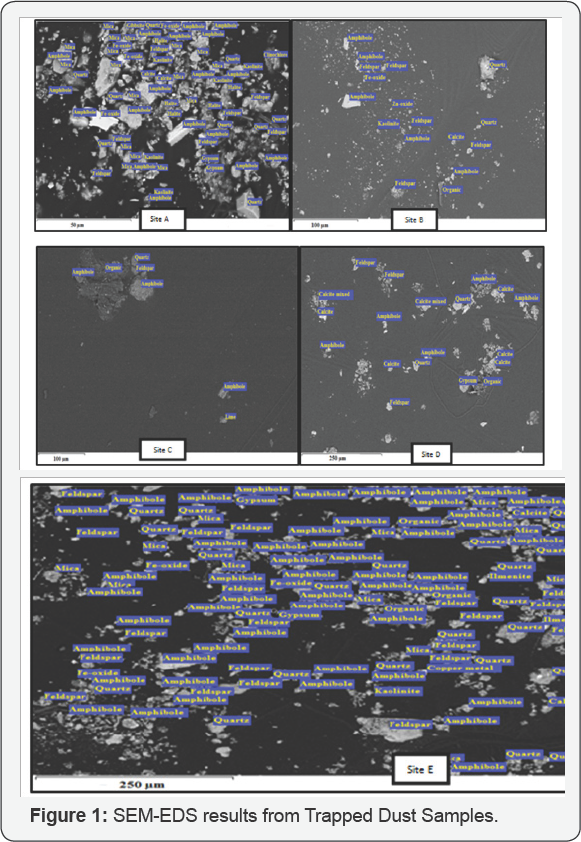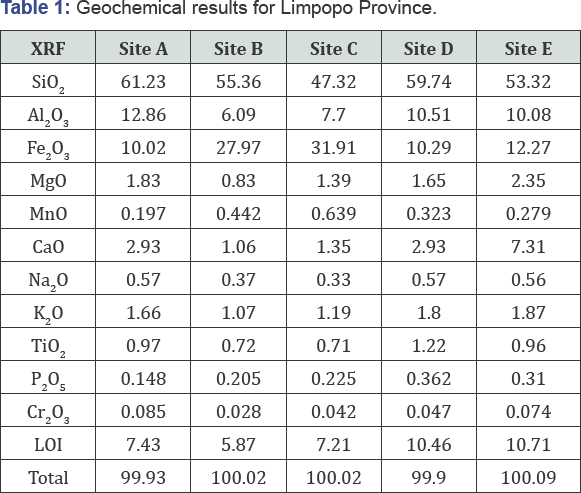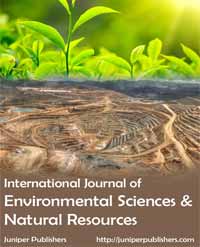Genotype and Environment Interaction Determines the Yield Potential of a Crop under Changing Climate - Juniper Publishers
Juniper Publishers- Open Access Journal of Environmental Sciences & Natural Resources
Genotype and Environment Interaction Determines the Yield Potential of a Crop under Changing Climate
Authored by Kwata Maphuti Georgina
Abstract
The physical characteristics and composition of dust material are essential in the study of soil contamination. The aim of the study is to determine the possible asbestos contamination in dust samples collected both outside and inside of homes villages that are close proximity to former asbestos mining areas. Asbestos is a silicate mineral that was mined in South Africa, but its mining was ceased in 2002 due to human health effects associated with inhalation. In January 2017 outside surface dust samples were collected in yards with a brush and plastic dust pan, sieved on site with 1.8 mm pore size stainless steel sieve to remove large particles and put into a labeled zipper plastic for storage. Trapped dust samples were collected on pieces of sticky tapes on hard surface both indoor and outdoor of homes and stored in sealed containers. The geochemical and morphological data were generated using (XRF) X-ray fluorescence and (SEM-EDS) Scanning Electron Microscopy - Energy Dispersive Spectrometry presented in the study is for January 2017. The samples were chemically treated and coated with carbonated before the analysis commenced. The main finding from this pilot study is that reported amphibole silicate asbestos mineral was detected at all the five sites. Previous studies have reported some of the dangers of inhaling asbestos fibres to include inflammation of the affected lung tissue, lung diseases and cancer of the lung tissue. Thus, its imperative that exposure to asbestos pollution should be eliminated or minimized.
Keywords: Surface dust; Trapped dust; Asbestos; Former mining areas; XRD, SED-EDS
Introduction
Mining of asbestos has left behind health and environmental problems [1]. Historically the asbestos materials were used for building roof, ceiling, and brake pads for vehicles [2]. While asbestos mining began little was unknown about the danger of the mineral due to the human and health effects [3]. Besides the banning of asbestos in 2002 is still contributing to the human health effects. Asbestos fibres mass is less 1 g which can be easily getting lifted in the air and suspended until transported to the close local communities [4]. There were cases of asbestos related diseases on the following mesothelioma, lung cancer and asbestosis which contributed to the high mortality due to the asbestos mineral "miracle mineral" [5]. The purpose of the study is to determine the geochemical and morphological composition from surface dust and trapped dust samples collected in the local communities in the vicinity to the derelict and abandoned mine dumps in Limpopo Province.
Experimental Procedure
Study Area
The study was undertaken within the following five local communities (Ga-Malemang Village, Ga-Mafefe - Mathabata Village, Penge and Taung Village) located in Limpopo Province (formerly Northern Province) in South Africa. Site B is fully rehabilitated and Sites A, C, D and E are partially rehabilitated. These communities are located near the old and abandoned asbestos mine dumps. The province has bushveld, majestic mountains, primeval indigenous forest, unspoilt wilderness and patchworks of farmland [6]. The geology of the province contains the Transvaal and Chuniespoort group; carbonate rock formation (contains iron and magnesium embedded in the rocks) form part of the dolomite series in succession near the top, which is followed by carbonate rock formation [7]. Most rocks in the province belong to the Malmani Subgroup and Penge formation. The most common rocks found in the province are shale, dolomite, chert, quartzite, conglomerate, breccia and diamictite [8]. Penge is an old town situated approximately 48 km north-west of Burgersfort, in the Greater Tubatse Local and Greater Sekhukhune District Municipalities. The asbestos mines were located south of the Pietersburg asbestos fields [9] and extend in an 80 km arc from Malisdrift in the north-west to the confluence of the Olifants and Steelpoort Rivers in the southeast[1] . The Penge asbestos mine and village are located in the southeastern extremities of the Pietersburg asbestos field [10]. Ga- Malemang village is situated in north-east of the province where the capital city of province is located on the road to Polokwane. The village is 30 km away from Polokwane and along the road there is smelter. Ga-Mafefe is situated in the north-west of the province where is the road to Burgersfort and Penge, Taung Village are 48 km away from Burgersfort town.
Sample Collection Method
Surface dust samples were collected using a brush, dust pan, sieved on site with 1.8 mm pore size stainless steel sieve to remove large particles and put into a labeled zipper plastic for storage. Trapped dust samples were collected using on pieces of sticky tapes on hard surface both indoor and outdoor of homes and stored in sealed containers.
Laboratory Procedure
Surface dust samples were analysed with the (XRF) X-ray fluorescence and trapped dust samples were analysed with the SEM-EDS (Scanning Electron Microscopy - Energy Dispersive Spectroscopy). The XRF is used to quantify the geochemical composition, while SEM-EDS are used to determine the physical or morphological features of the dust particles or fibres. Pieces of sticky tapes substrate containing trapped dust samples are mounted on specialised filter holders for SEM-EDS investigationsfollowed the method described by Atanasova[11]. All the specimens for SEM-EDS are coated with carbon to provide a conductive surface for optimum imaging. The XRF analysis major element analysis the milled sample (<75 |i fraction) was roasted at 1000�C for at least 3.0g hours to oxidize Fe2+ and S and to determine the loss of ignition (L.O.I.). Glass disks were prepared by fusing 1.0 g roasted sample and 10 g flux consisting of 49.5% Li2B4O7, 49.5% LiBO2 and 0.50% Lil at 1150�C. Quality control/Quality assurance was done by using an in-house amphibolites reference material (sample 12/76). Also 1.0 in every 10 samples is duplicated during sample preparation. For trace element analysis 12 g milled sample and 3.0 g Lico wax was mixed and pressed into a powder briquette by a hydraulic press with the applied pressure at 25 ton. The glass disks and wax pellets was analysed by a PAN Alytical wavelength dispersive Axios X-ray fluorescence spectrometer equipped with a 4 kW Rh tube [12].
Results and Discussion
The geochemistry results in (Table 1) shows the oxide of silicates of oxide silicon oxide (SiO2) ranged from 47.32 to 61.23 wt. %, aluminum (II) oxide (Al2O3) ranged from 7.7 to 12.86 wt.%, iron (II) oxide (Fe2O3) ranged from 10.02 to 31.91 wt.% and magnesium (II) oxide (MgO) ranged from 0.83 to 2.35 wt. %. These geochemical results only confirm the presence of silicates minerals. The asbestos mineral is one of the many silicate minerals that are suspected to still be present within the study area. (Figure 1) shows the amphibole [NaCa2 (Mg,Fe,Al)5O22(OH)2] mineral groups to be the most common asbestos mineral to be identified or present in all the five sites. The other silicate minerals detected were quartz [SiO2], kaolinite [Al2Si2O5(OH)], mica[KAI2(Si3Al010)(0H)2] and IIImenite [Fe2TiO3]. The non-silicate minerals detected were gibbsite[Al2(OH)3], calcite[CaCO3], Fe-oxide, organic, gypsum, lime, halite and clinochlore[Mg,Fe+5Al(Si3Al)O10(OH)8]. Previous studies by Moja [13]; [14,15] reported the amphibole asbestos mineral group being dominant in comparison to the and serpentine asbestos mineral group.


Conclusion
Since all the sites under investigation tested positive for the presence of the amphibole asbestos mineral group, it implies that the locals are continually being exposed to it. Urgent rehabilitation is recommended to reduce the health risks of these communities.
To know more about Juniper Publishers please click on: https://juniperpublishers.com/manuscript-guidelines.php
For more articles in Open Access Journal of Environmental Sciences & Natural Resources please click on: https://juniperpublishers.com/ijesnr/index.php




Comments
Post a Comment